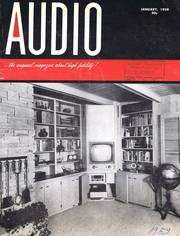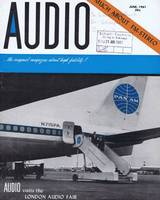Erläuterungen zu diesen US-AUDIO Seiten der 1950er Jahre
Die hier stehenden amerikanischen Artikel aus 1959 (aus der US-AUDIO) sind teilweise sehr gewöhnungsbedürftig, weil sie erstens aus einer längst vergangenen Zeit stammen und zweitens, weil dort in den USA ganz "anders" gedacht wurde als bei uns in Old Germany oder in Europa.
Vergleichbar mit unseren deutschen Hifi-Magazinen etwa ab 1962 ist jedoch, daß auch diese Zeitschrift ihre Anzeigen- Kunden und -Leser (be- oder ab- ?) werben mußte. - Weiterhin sind die Dimensionen des amerikanischen Kontinents mit den unseren hier in Europa nicht vergleichbar. - Ein Redaktions-"Trip" von New York nach Los Angeles oder Chicago oder gar in die Wüste nach Las-Vegas zu einer der CES- Audio- "Shows" war - auch mit dem Flugzeug - immer noch eine Weltreise. Und jede Ausstellung oder "Messe" wurde als "Show" deklariert. Und natürlich, in USA musste alles "Show" sein, um beim Publikum einige Aufmerksamkeit zu erzeugen.
Der Autor Edward Tatnall Canby schreibt jeden Monat "AUDIO"
Sowohl in den monatlichen EDITOR's REVIEW's als auch in den monatlichen ETC's lesen wir ein Stück amerikanischer Gesellschaftsgeschichte vom Ende der 1950er Jahre. Dazu gehören auch die frühen monatlichen Schallplattenbesprechungen, in denen sehr viel Wissen rund um die Musik, die Gesellschaft und die Hifi-Technik eingeflochten wird.
.
In der Juni 1961 Ausgabe der US-AUDIO steht es ausführlich
Der Kolumnist Edward Tatnall Canby schreibt in seiner monatlichen Kolumne, wie er das mit dem von der FCC verordneten (oder befohlenen) landesweiten STEREO Rundfunk aufgenommen/erfahren hat und wie er darüber denkt. Der Artikel ist - auch im Nachhinein - so vernünftig und realitätsnah, daß er unbedingt gelesen werden sollte.
Im Vorgriff ist es gut zu wissen, daß in den USA ab etwa 1958 sogar 14+1 (fünfzehn) verschiedene Konzeptionen eines Stereo-Rundfunks entwickelt wurden. Davon wurden sieben von der FCC sofort (Juni 1960) aussortiert, auch sonst waren es fast allesamt Krücken, die zum Teil nicht abwärts kompatibel zum vorhanden Mono-FM Radio waren und teilweise den 2. Stereo-Kanal über Mittelwelle andockten. Weiterhin wäre es zum Verständnis wichtig, daß in den USA in dem bisherigen FM Mono-Sendekanal versteckt eine Hintergrundmusik für Gewerbetriebe wie Restaurants und Shopping Malls mitgesendet wurde.
.
Die grosse Überschrift des Artikels ist darum weniger wichtig. Der Autor bzw. Kolumnist schreibt seit Jahren hier in der US-AUDIO jeden Monat über seine aktuellen Eindrücke und Erlebnisse :
AUDIO E.T.C. by Edward Tatnall Canby
.
THE GOOD NEWS - STEREO BROADCAST (Juni 1961)
Well, the first glossy photo of a real, honest-to-goodness FM-multiplex stereo adapter has just come in the mail (cost $99.50), the F.C.G. decision on stereo broadcast is still a breathless bit of news - and it seems I made another of my left-handed prophesies. (A left-handed prophesy is one that was written before but published after the fact.)
I said last month that maybe broadcast stereo would be this season's coming high sensation. It will be, as witness this issue of audio, given over to the good news that took so long in coming.
You will of course look elsewhere in audio for the technical description of the wining system, if you haven't had it lying around in your files for a year or so already.
(My General Electric press release on this system came to me in the spring of 1960.) It is my business to take the wide view and observe what I may as to the implications.
Well frankly, I am delighted.
For it seems to me that a situation which three years ago looked like a real "mess," insoluble unless either an existing industry were to be wiped out (the music stations broadcasting multiplexed restaurant background material on a subscription basis), or unless the quality of FM stereo broadcasting were to be seriously compromised, has instead been resolved with all parties happy.
We have found a way to have our cakes and eat them too, without coin-promise, or so I gather at this point. And the method is ingenious to the point of wonderment - why didn't somebody think of it earlier, back in the acrimonious days of the Crosby-Halstead arguments ?
Genius, to paraphrase the familiar phrase, is an infinite capacity to be simple. If I am right, the men at G.E.-Zenith (I'll make no distinctions) are to be congratulated for just that sort of simplicity. They figured a way to avoid all the clashes and conflicts and compromises and counter-accusations of the rival camps that first tried to launch stereo broadcasts three years back, and, it seems, their system is possibly superior even to the best of the original propositions. Hard to believe.
Components Plus ......
You'll probably read that the prime feature of the now-accepted G.E.-Zenith system is that it requires only a relatively inexpensive conversion unit, the multiplex decoder, utilizing only a single tube in its simplest arrangement.
True, this is a big advantage. It's a vital one in view of the huge importance in radio of the mass market, both the small mass-produced radio sets and the millions of large, mass-produced consoles. The fact is, of course, that component-style radio is all very fine, but radio itself, i.e., broadcasting, can't get along only on components. If we are to have broadcasting or any sort, it must be based on components plus mass-produced equipment. Period. (Punkt !)
The broadcast system that will be successful - obviously must provide a dual basis:
- (a) the means for top-quality sound, in the broadcast and in the reception, and
- (b) simultaneously, the means for simple, low-cost, mass-production receiving equipment.
.
Mittelwelle (AM) war niemals von guter Qualität
AM radio has never, except in special cases and special areas, provided the full top-quality potential in actual practice, but has fulfilled the mass-production aspect admirably. That's why AM still horses along, in spite of TV and FM combined.
FM broadcast, mono, has done an admirable job from the beginning on the first proposition - top quality sound for top-quality reception. Unfortunately, FM's mass-production capabilities were underplayed at the beginning, and the medium almost went under for good. (I was in on that near-debacle myself; I lost a good job right after the war when the FM boom failed to materialize as predicted.)
Now, happily, in the last few years FM has found itself, partly boosted up by increasing component sales and the general impact of the idea of hi-fi, but also buoyed by an increasingly solid mass-production basis in the receiver area.
Blicken wir auf die letzten 10 Jahre zurück
Now - who'd have guessed it even ten years ago? - we have transistor FM-AM pocket radios, not to mention all other sizes. Sound quality is not exactly the strong point in these models. Their mere existence proves my point, that quality broadcast depends on non-quality mass-production reception.
FM, then, is on solid ground at last, in the mono medium. And meanwhile stereo, in spite of its not-very-handsome progress, has slowly taken over more and more ground, everywhere but in radio.
The persistence of the clumsy AM-FM stereo broadcasts and a few FM-FM arrangements shows that the missing link of broadcast stereo has been a very real one.
After all, it is the last link in the chain of linked elements that includes stereo discs, stereo tape, tape recorders and players, the home hi-fi component system and mass-produced stereo "hi-fi" (quotes are traditional with me). (You'll note that we now have another new noun in the business. A few years back, "hi-fi" became "the hi-fi"; now one goes out and buys a "stereo.")
Compromises
Thus, to go back to my earlier point, the new stereo broadcast system faced the two vital requirements that would somehow have to be met, both of them - top quality throughout, plus adaptability for inexpensive mass-production receiver equipment.
If both a stereo hi-fi band and one or more background music bands were to be carried piggyback on a single FM transmission via multiplex, there just didn't seem to be any way in which they could keep out of each other's hair and yet remain uncompromised in sound quality.
Even the reasonable compromise in the assigned bandwidths prepared by Editor McProud was still based on the premise that we had to have both stereo and background music, on the same broadcast signal, imposed in the same manner and thus still potentially subject at least to accidental interference.
What nobody saw, at that time, was the brilliant possibility - so simple - that if we could multiplex these two different and competing signals - one hi-fi music, the other mood music - by different systems upon the same FM broadcast carrier, there would be no interference. The two would not recognize each other, nor, so to speak, be aware of each other's existence, though part of the same basic signal wave.
This was the blindingly happy General-Electric - Zenith idea.
The question was merely - how. And it must have taken a while to work out the details, since this system did not appear in public and before the F.C.C. until a good while after the earlier proposals.
Anmerkung : Die amerikanische FCC hatte bis dato nichts von den G.E./Zenith Eigenschaften publiziert -warum nicht, wird noch herauskommen.
Again, I refer you to more detailed explanations elsewhere, but just marvel with me at the neatness of the very concept itself:
Put your second stereo signal, (the difference signal), onto the main carrier via an amplitude modulated sub-carrier, suppress the carrier, and use the remaining AM sidebands to frequency modulate the main FM carrier. Then, higher up (you have to 75kc), put the background music signal on the same carrier via the present FM multiplexing. Thus the two will be mutually exclusive; the detector that brings one of these signals to life can't even "hear" the other signal at all. It's wonderful !
It Looks Like This
As the Boss explained the inner details to me (he's the best teacher I've ever run into), the FM stereo transmission under the new system will look like this - I'll give it to you in my lay words, just as a side-prop to the more proper engineering accounts elsewhere.
Wie (amerikanisches) UKW Stereo funktioniert :
From 50 to 15,000 cps, on the FM carrier (dem UKW Sendekanal) is the main or sum channel, receivable as a standard FM mono transmision.
At 19,000 cps there's a control "synch" signal, to grab the local oscillator (producing the subcarrier) in the home multiplex receiver, similar to the TV arrangement. That oscillator runs at 38,000 cps, the second harmonic of the control signal.
Then from 23,000 to 53,000 cps, still on the FM main transmission, is the vital AM multiplexed signal, 15,000 cps wide on each side of the 38,000 cps AM carrier frequency, suppressed at the transmitter - only the side bands go out on the air.
What? said I, the sides without the middle? Sounds to me like a bottle of milk without the bottle. Yet so it is.
The oscillator in your home receiver puts back the 38,000 cps, synchronized by that 19,000 cps control tone. And the simple fixed AM detector just tunes in on it, removing an AM sound-signal.
And 'way, 'way up in the FM stratosphere, still on that same main FM carrier, going on up to the limit, 75,000 cps, is the piggyback FM-multiplexed background music signal, different music, for different receivers.
It's far away from the lower FM signal, whose top is 15,000 cps. And it can't even hear the AM signal that fits in between. Neat, neat, neat!
FM-Stereo von G.E. and Zenith - ist vor allem "störungsfrei"
No interference, top stereo quality (50-15,000 cps on both the sum and difference signals) and everybody is happy. Cheap receivers too, or so I hear, in spite of that $99.50 job I mentioned. That is - cheap equipment is inherently possible and satisfactory within its own sphere of operations.
Mighty important, I tell you, even if the top product does cost $100, self-powered. Imagine if it cost $99.50 to buy any stereo adapter. Or even $39.50. It won't, if all goes well.
Now there's only one pay-off to mention here. I wonder just how many hopefully thinking audiofans have jumped to a conclusion that is as likely as a short circuit in a wet distributor.
Er beschreibt eine der alten UKW-Mittelwelle Stereo-Testsendungen und deren Macken :
Namely, that AM for the second (difference) stereo channel is bad, because it'll be subject to static and noise (whereas the main signal, FM, is immune to the noise) ?
This, of course, was one of the most violent objections most of us had to the old FM-AM stereo broadcasts, one stereo channel via the FM transmitter and the other via AM. The noise, in one channel but not in the other, was far more distracting than the difference in tonal quality between the two channels.
Do we have that problem again here, with FM and AM both in use?
Of course not! I almost fell into this trap myself, but managed to save myself and my reputation just before I sprawled. This AM is multiplexed upon a carrier FM signal; it doesn't exist in "free air" so to speak. The receiver picks up only the FM signal, carrying with it three different messages. The AM part is purely internal, if you see what I mean. So - no static.
Sure, sure, elementary; but I'll bet a lot of folks get tangled up on this little point, just the same.
.
Zum Abschluß noch ein Kommentar zur amerikanischen F.C.C.
Sometimes I wonder what it must be like to be a "lay" member of that august body, the F.C.C. The explanations that must go on, with millions of dollars hanging on every word!
Lay or no, I'd say that the new F.C.C. has done a good job this time, seeing a good thing when it was presented, coming to a relatively quick decision in view of the "recency" (as Mr. Harding might say, he of that famous word, normalcy) - the recency of the new set-up.
We'll all be talking more, much more, about the forms of equipment that are now likely for stereo broadcast and the forms of stereo entertainment that may crop up.
That, of course, is very much within my own province and if anybody around here wants a guy who knows the technical ropes of stereo and the parallel ropes of its main signal - the art of music - I'm all set to produce stereo music broadcasts galore.
I can even explain sum and differences to the folks "out thar," if I have to. That takes explaining let me tell you, especially to Aunt Mamie, who thinks "stereo" is something she saw in the movies, with a giant screen.
Have recorder, can edit. End of plug.




